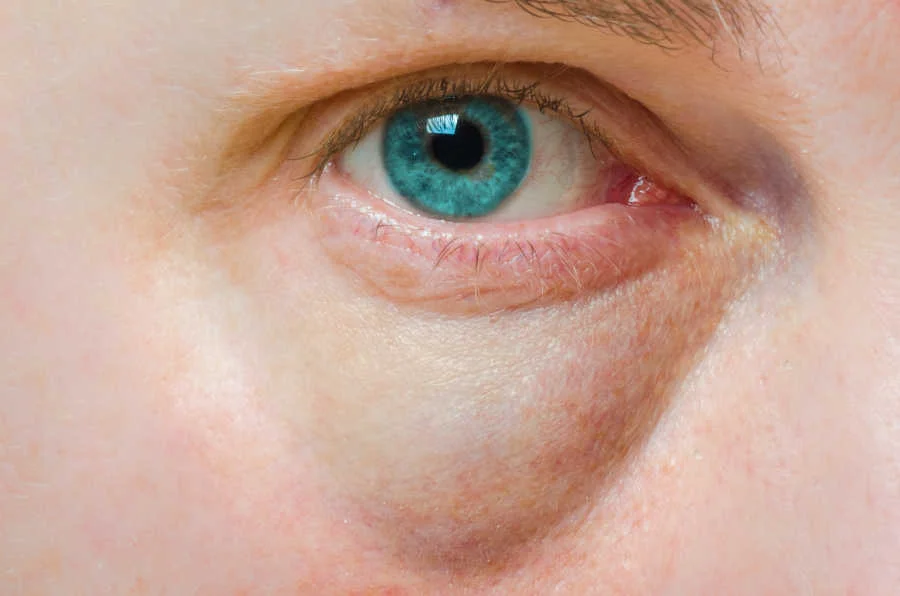As an Amazon Associate, I earn from qualifying purchases and other affiliate links. I only recommend products I’ve tried or researched.
- Home
- Reduce Puffy Eyes
- Filler for Under Eye Puffiness
- Swelling After Tear Trough Filler
Swelling After Tear Trough Filler: What’s Normal (and When to Check In)
by: Linda Robison / Facial Fitness Specialist
After years of helping women with puffy eyes, I can tell you this: the under-eye area reacts to everything — sleep, salt, stress, crying, even a new eye cream.
So it makes sense that it might swell up a little after something as simple as a tiny tear trough filler injection. This area just tends to be expressive.

The under-eye area is sensitive, and a little swelling is one of the most common things that happens after injections.
In this guide, I’ll show you what typical post-treatment swelling looks like, how long it tends to last, and a few gentle ways to help the area feel more comfortable while you heal.
Quick answer
Most under-eye swelling after tear trough filler is completely normal and usually eases within a few days to a week.
The eye area often looks puffier in the mornings and gradually settles throughout the day.
If anything feels unusual for you, it’s always smart to check in with your injector.
Why the under-eye area reacts so easily
This is the part many people don’t realize:
The under-eye area puffs up from almost anything.
- A salty dinner.
- Sleeping flat.
- Crying.
- Stress.
- Hormones.
- Seasonal allergies.
- Even switching to a new eye cream.
The skin here is thin, delicate, and very expressive.
The under-eye area reacts to everything. So it makes sense that it might look fuller or swollen for a bit after any small irritation.
When you see it this way, the early swelling after filler doesn’t feel so alarming — it’s just how this area naturally behaves.
What normal swelling usually looks like
Days 1–3:
A little puffiness, especially first thing in the morning.
Some unevenness or tenderness is completely expected.
Days 4–7:
Most women notice the area calming down and makeup applying more smoothly again.
After one week:
Swelling tends to fade and the under-eye area looks more like it normally does — just a bit smoother or more filled, depending on your treatment goals.
Note: Everyone’s skin reacts differently. Some people settle quickly, others take the full week.
Gentle ways to feel more comfortable after tear trough filler

These aren’t treatments — just simple comforts that help the area feel less heavy while swelling improves naturally.
1. A cool, soft compress
A cool (not icy) cloth can make the area feel calmer.
2. Sleep with your head slightly raised
Even one extra pillow can help fluid move downward instead of collecting under the eyes.
3. Avoid rubbing or leaning on your face
Try to keep the area as undisturbed as possible.
4. Lighten up on salty snacks
Salt naturally draws fluid under the eyes — something many of us over 40 notice more than we used to.
5. Give your skin a little patience
The under-eye area tends to look dramatic at first, then settles nicely as the days pass.
When it may be time to check in with your injector
Everyone’s healing looks a little different.
If something feels out of character for your skin — or if the swelling isn’t gradually improving — it’s completely fine to reach out and ask.
You’re not diagnosing anything; you’re just giving your provider a chance to guide you.
Bottom line:
You know your skin best. If something feels “off,” trust your instincts and get reassurance from the expert who treated you.
Tear trough filler after first week
The most common message I hear from women is:
“I looked more tired before I looked better — but it didn’t last.”
The swollen stage feels dramatic because it’s right under your eyes, but it’s usually temporary. As swelling fades, the under-eye area begins to look smoother and more rested.
Most people are pleasantly surprised once they get past those first few days.
Extra help to looking less puffy after trough fillers

If you want extra help looking less puffy while you heal…
You may find these pages helpful:
- How to Reduce Puffy Eyes
- Best Serums for Under-Eye Puffiness: My Tested Reviews
- How to Look Less Tired: Quick & Easy At-Home Tips
- Plexaderm vs Competitors (helpful for a temporary “smoother” look)
All gentle, non-medical, and easy to use while your under-eyes settle.
Final thought on swelling after tear trough filler
Under-eye swelling after filler can feel like a surprise — especially if you weren’t expecting it — but for most people, it’s simply part of how this delicate area responds to change.
A little time, a little elevation, a cool compress, and gentle care are often all it takes for things to settle beautifully.
And if anything feels unusual for you? A quick check-in with your injector brings clarity and peace of mind.
You’ve got this — and you’re not alone. ❤️
FAQ: Swelling after tear trough filler
Q: How long will I be swollen after tear trough filler?
Q: How long will I be swollen after tear trough filler?
A: Mild swelling after tear trough filler is very common and often improves over the first few days, with most people feeling more settled by about a week. Everyone’s skin is different, so if your swelling doesn’t seem to be easing or feels unusual for you, it’s always a good idea to check in with your provider.
Q: What should I not do after tear trough fillers?
Q: What should I not do after tear trough fillers?
A: Most providers prefer that you keep pressure off the under-eye area, avoid rubbing, and skip strenuous exercise right after treatment. Your injector will give you specific aftercare instructions based on your skin and medical history, so follow their guidance if you’re unsure.
Q: How long does bruising last after tear trough filler?
Q: How long does bruising last after tear trough filler?
A: Bruising can vary from person to person. Some people notice only mild discoloration that fades within several days, while others may see faint bruising that lingers a bit longer. If you’re concerned about how your bruising looks or feels, reach out to your provider for reassurance.
Want simple facial fitness tips you can actually stick with?
I share quick routines, skincare tweaks, and what’s working for me — straight to your inbox.
About the Author:
Linda Robison is a Facial Fitness Specialist and the founder of Anti-Aging Beauty Zone. With decades of hands-on experience, she shares practical, natural ways to lift and brighten mature skin—without expensive or invasive treatments.
Before you go ....
Please tap on the💙in the bottom right corner if you found this page helpful.
FOLLOW ME FOR MORE TIPS:
SHARE OR SAVE FOR LATER:


